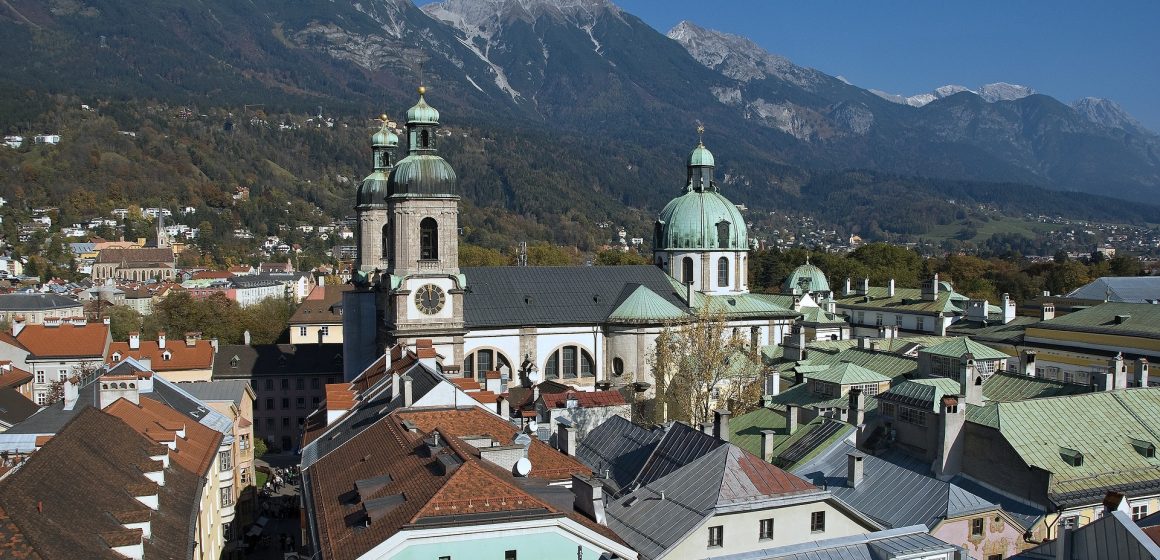Day 1 – Mount Nordkette
The symbol of Innsbruck – House with a golden roof (Herzog-Friedrich-Straße 15) attracts the attention with magnificent tiles, which consist of 2,657 gold-plated copper sheets, preserved in its original form. Here begins the old, gothic part of the city, which is imbued with the spirit of the late Middle Ages. It overlooks the Column of St. Anne (Annasäule), located on Maria-Theresien-Straße, where you can walk, shop and sit in cozy cafes, admiring the luxurious baroque buildings. A short walk through the old part of the city will lead you to the bridge across the Inn River. It is to this river that the city owes its name. Council: Those who want to take a piece of the famous Roof home should definitely look into the Munding or Zimt & Zucker pastry shops. In them you can find a sweet version of the golden tiles.
On the same street as the House with the golden roof are the City Tower and the Helbling House (Helblinghaus). To climb to the observation deck at a height of 31 meters, you have to overcome 133 steps. From here you can see not only the cozy medieval streets, but also the Bergizel and Pacherkofel mountains, the Inn River and the Nordkette cable car. Gelbling Mansion, located in the Old Town, was built in the late Middle Ages. In 1730, Anton Guigl decorated the building with a luxurious stucco facade, and in the nineteenth century, Sebastian Gelbling opened a cafe in this house.
The next attraction is the “Little Alpine Schönbrunn” (Rennweg 1). So, at least, Empress Maria Theresia (1717–1780) called the Hofburg Palace of the Hofburg in Innsbruck, which by her order was built in the late Baroque style. Today you can admire the impressive frescoes by F.A. Malbercha and portraits of the imperial family. In the second half of the nineteenth century, the apartments were newly furnished with furniture for Empress Elizabeth.
For visitors are available:
· Luxurious rooms furnished according to the taste of Empress Maria Theresa: Reception Hall, Giant’s Hall, Council Room.
· Imperial apartments
· Chapel, sacristy
· Hall of coats of arms
Day 2 – Ambras Castle
Ambras Castle is one of the most important sights of Innsbruck. Its cultural significance is inextricably linked with the name of the Archduke Ferdinand II (1529-1599). He assembled a magnificent collection of armor, weapons, works of art and strange objects, which is still represented in the castle. On three floors there is a portrait gallery with images of the Habsburgs, starting with Albrecht the Third (1349-1395) to the emperor Franz I (1768-1835). The collection includes more than 200 paintings, among which are valuable works of such famous artists as Lukas Cranach, Anton More, Titian, van Dyck and Diego Velasquez. On the ground floor in the Upper Castle are works of the late Middle Ages. The gem of this collection is the altar of St. George, built under the emperor Maximilian I.
The following expositions are presented here:
· Armouries
· Kunstkamera and gallery of miracles
· Rudolf Strasser Glass Collection
· Portrait Gallery of the Habsburg Dynasty
· Collection of Gothic sculptures
Day 3 – Mount Nordkette
From the city center to the mountains is the cable car. From Congress Station, located not far from the Hofburg Palace (Rennweg 3), you can reach the Zeogrub Mountain, which is 2000 meters high, in 20 minutes. Those who wish can drive 300 meters up to Mount Hafelekar and enjoy the stunning panorama of the Alpine peaks. From the station Zeegrube to the top of the mountain Hafelekar can be reached on foot in 20 minutes.
Hiking trails to mountain huts and alpine meadows start from cable car stations. Choose the appropriate:
· From Hungerburg station to the restaurant-hut Arzler Alm – 45 minutes
· From Seegrube station to Bodensteinalm hut – 1 hour
· To the hut Goettinger Alm (Höttinger Alm) – 1.5 hours. There are many hiking trails in the Karwendel Nature Reserve. On the way, you will meet huts where you can eat and even spend the night.
· The Goetheweg route to the Pfeishütte hut and back is 4.5 hours.
Ticket price for adults (round trip):
Innsbruck – Hungerburg: 8.60 Euro
Innsbruck – Zeegrubie: EUR 29.70
Innsbruck – Hafelekar: 33 Euro
Back to the valley
The last ride down the cable car Hafelekarbahn – at 17:00, from the mountain Zeegrube at 17:30. On Fridays, the road runs until 23:30.
The Hungerburgbahn cable car (Hungerburgbahn) is open until 19:50. If you want to go down a little later, you can take the bus on route J. The bus stop is a few meters away from the Hungerburg station. The last bus leaves at 22:26.
Source: https://www.austria.info/ru/chto-posmotret-v-insbruke-z-1-3-ili-7-dnej

